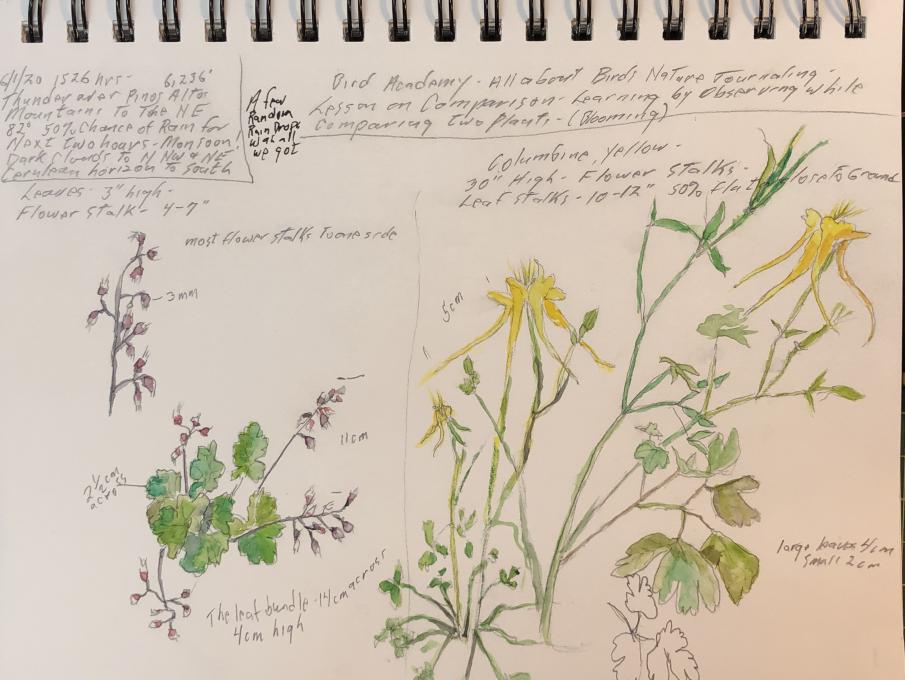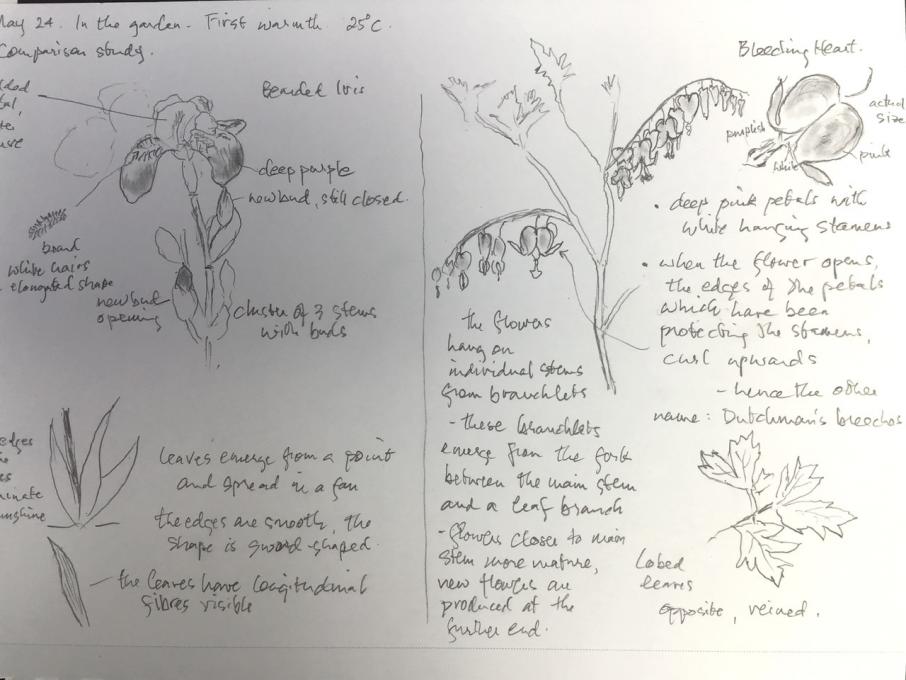The Cornell Lab Bird Academy › Discussion Groups › Nature Journaling and Field Sketching › The Power of Comparison
-
Just spending time in my backyard, comparing flowering annuals. Trying to get better at drawing what I see.

-
I have done three comparisons - in my garden, two flowering plants which are difficult for me to identify until they flower - scarlet lynchnis and four o'clocks; kayaking up Little River in Washington County, Maine, two finely divided leafy submersed plants which I later identified as water marigold and large purple bladderwort; and walking through Moosehorn Wildlife Refuge in Washington County, Maine, two ferns, interrupted fern and Christmas fern. The exercise has been very helpful for me in looking closely at the parts of plants and learning the proper vocabulary for describing them as well as thinking about form and function.
-
Observation! Becoming better at observing was one of the main reasons I wanted to take this course. I find identifying plants in nature so difficult - I hope this will help. To that end, I compared twig cuttings of two different species of mesquite in my yard. And I absolutely noticed so much more than I would have, using the comparison method! My written comparisons are on another page, and I have already added more questions and possible answers as they pop into my head. I hope when I start using a different notebook, my pages will become more pleasing to the eye, overall. I am trying to cram too much on one page, I think. It was a lot of effort, drawing all those leaflets! By the time I was done with the overall sketch of each, I was nearly out of steam to do proper secondary drawings.

-
1. It's not quite spring here so I couldn't find anything in flower. Mine is a small shrub comparison. This exercise made me really curious about why there is so much difference in the leaf type of two plants in the same environment. 2. I like the mix of multiple drawings, notes and measures. I appreciate the idea of having the full subject rough sketch to go alongside the more focused sketches. Adding the questions, not just the observations and data is really powerful to me.

-
 Enjoyed this exercise, found I noticed more details about each plant.
Enjoyed this exercise, found I noticed more details about each plant. -
 Really an intimate way to intersect art and discovery. This slow introspection allowed me to see the wonder and beauty of something I was quite fearful of prior to the study. As Hurricane Laura was not far from my area, I ventured inside and retrieved a matchbox with specimens from my yard. Originally meant for my grandchildren, I found myself the student! I have a greater appreciation for this noisy summer cicada.
Really an intimate way to intersect art and discovery. This slow introspection allowed me to see the wonder and beauty of something I was quite fearful of prior to the study. As Hurricane Laura was not far from my area, I ventured inside and retrieved a matchbox with specimens from my yard. Originally meant for my grandchildren, I found myself the student! I have a greater appreciation for this noisy summer cicada. -
1.I tried a Venn diagram with the butterfly bush and hydrangea, and saw many similarities and differences, like how butterfly bush has a bit of red on it. 2. I did a lot of small drawings to give a visual, then lots of observations.

-

-
this is really lovely! It's like you adapted your handwriting to the shape of each tree. Even more awesome if you didn't do it on purpose :)
-
-
I compared butterfly bush and black-eyed susan in my garden. Either my sketchbook is too small or I tried to cram too much information in--I suspect this would be a problem with a larger notebook because there is so much to compare. I may try and think more ahead of time about whether I making a general comparison to identify something or if there is something I specifically want to compare. I didn't leave enough room to write down questions.

-
 I compared two plants in my garden that I see every day but was looking at their details for the first time.
I compared two plants in my garden that I see every day but was looking at their details for the first time. -
Those are awesome drawings, what a creative way of organizing you page
-
-
 I compared two flowering plants in Parc Micaud, Besançon (FR). This comparative exercise is so useful for probing into questions of form. I would have liked to have a magnifying glass at hand to learn more; it was quite difficult to see some of the finer details with the naked eye but I had the feeling there was much more to learn!
I compared two flowering plants in Parc Micaud, Besançon (FR). This comparative exercise is so useful for probing into questions of form. I would have liked to have a magnifying glass at hand to learn more; it was quite difficult to see some of the finer details with the naked eye but I had the feeling there was much more to learn! -
I did with two garden plants, I think that when you compare , you pay much attention to details.

-
 I selected a familiar wild flower and then one I was not familiar with. I was a little overwhelmed by the second one (Right side) . I think the Queen Anne’s lace was closer, easier to see and observe. The second one was more complicated but did make me think of a lot of questions about the flower portion, and leaves. Great exercise!
I selected a familiar wild flower and then one I was not familiar with. I was a little overwhelmed by the second one (Right side) . I think the Queen Anne’s lace was closer, easier to see and observe. The second one was more complicated but did make me think of a lot of questions about the flower portion, and leaves. Great exercise! -
Good idea to select a flower you are familiar with and one you are not. I didn't think of that.
-
-

 Such fun. I found tiny flowers where I thought there were only berries and flowers that seemed to grow from the base of leaves. The leaves were so different. Hard shiny plastic for the red berry and rough as a fine sandpaper for the second, although they looked so soft. Both weeds I suspect, next to a road. I could not find anything similar when I searched for names.
Such fun. I found tiny flowers where I thought there were only berries and flowers that seemed to grow from the base of leaves. The leaves were so different. Hard shiny plastic for the red berry and rough as a fine sandpaper for the second, although they looked so soft. Both weeds I suspect, next to a road. I could not find anything similar when I searched for names. -
I compared two Florida flowering shrubs: the Firebush and the Golden Dewdrop. The Firebush has orange tubular flowers growing in clusters with medium sized continuous leaves. After the flowers bloom, they form dark red berries at the base of the flower. The Golden Dewdrop has tiny purple flowers growing downward in clusters. I noticed before the flowers bloom a tiny stem forms, then buds and then the tiny purple flowers bloom. It reminds me of a dewdrop and hence the name. Both bushes have similar leaves but they are not exactly the same. One is more elongated than the other. I learned that both flowers attract insects including butterflies. I believe the Firebush also attracts hummingbirds because of the flower's tubular shape. I learned that every flower has its unique qualities, but can attract similar insects. I can balance my drawings by using different sized plants, trees. colors. I discovered so many details on the bushes that I wouldn't have normally noticed until I started to sketch them.
-

-
I wouldn't have noticed how the plains coreopsis' younger shoots of leaves only have 2 segments where the fully mature and ones towards the base of the plant have 5 segments, with the 2 lower ones being forked. Also the black eyed Susan has the slightest blush of deeper yellow at the base of the petals (which I found even more noticeable when doing the squint test).

-
 I have tried the comparison study, I compared two trees in a barranca park, I started with the bark, tree, structure, color, leaves, and needles. I had about 30 minutes to complete the assignment. I did experience a bit of trouble with my spacing in my sketch book. Also need to sketch darker and with a better plan, will need more practice.
I wondered why these trees were planted in this park. I noticed that there were a wide variety of very tall trees and many species of birds. I think that bird diversity for habitat played a key role with the many choices of trees planted. And the needles seem to draw small bug eating birds to the ground under the conifer pine trees.
I have tried the comparison study, I compared two trees in a barranca park, I started with the bark, tree, structure, color, leaves, and needles. I had about 30 minutes to complete the assignment. I did experience a bit of trouble with my spacing in my sketch book. Also need to sketch darker and with a better plan, will need more practice.
I wondered why these trees were planted in this park. I noticed that there were a wide variety of very tall trees and many species of birds. I think that bird diversity for habitat played a key role with the many choices of trees planted. And the needles seem to draw small bug eating birds to the ground under the conifer pine trees. -
Doing a comparison study was a great learning experience. I did a study between a flight feather and a down feather - which with further study I realized was actually a semi-plume feather. The flight feather is a wing rather than a tail feather, I think. It has bands of faded light and dark browns. So, since it is faded, I believe it is an old, molted feather. It is 9 1/2 " and looks to be the feather of a red-tailed hawk. The semi-plume feather is quite beautiful with a striking spotted pattern. I plan to redraw it once my drawing skills improve! Also, I need to figure out how to identify this feather. The spots are probably a good clue.

-
I LOVE that you compared feathers!
-
-
I did a comparison study on two volunteer trees in my backyard. What I learned is that despite thinking that I pay attention to nature, I don't. I missed so many details. This exercise caused me to look so much more closely. I didn't know what one of the trees was. My tree key was of no help, which was extremely frustrating. My son-in-law identified it with his tree key as a White Mulberry. It turns out the White Mulberry was not in my key, only the Red Mulberry and only with mature leaves. Apparently the leaves change shape as the tree ages. Why? The other tree we confirmed was a White Poplar. I had never even noticed the unusual diamond pattern of its bark! The trees came to my yard via their underground system of root suckers from a tree in a neighbor's yard. This study led me down a path to find more information online, which lead me back to look at the trees, which led me back to more study and drawing, and on and on.

-
I remember becoming frustrated trying to identify a type of mulberry. Who knew the same tree could have so many different shaped leaves????
-
-
I’ve compared between the sand bubbler crabs and the black stone crabs. The sand bubblers crabs: light colour that resumable the sand, with redish tips. Have popping long eyes. And live under the sand (I’ve never noticed them eating! They are hard workers while the tide is low!) The black stone crabs: black with a hint of dark green colour. Have half round shapes eyes fixed to their body. And live between the rocks and walls by the shore. (Yes, I saw one eating from a green floating weed that got placed by the rocks due to the low tide - they can be spotted even at the high tide time between the rocks and walls) I need to sketch that in details :)
-
For years I have not been able to reliably tell the difference between two species of blue camas that grow in the Victoria area, common camas and great camas. Both species have blue flowers with six petals and both
 plants vary in size and colour. So, I decided this would be a good time to really look at both flowers to find some subtle differences.
plants vary in size and colour. So, I decided this would be a good time to really look at both flowers to find some subtle differences. -
This comparison of two plants brings more attention to detail and how the same part of two different plants can be so vastly different. The question of pollinators, who does it ... probably hummingbirds or specialized moths on the columbine but what about the tiny blossoms on the unidentified flower. Using words, numbers and drawings intensifies concentration.

-
Love the details and colors. Both plants are delicate, but so different.
-
-
I tried another comparison that looked at different stages of development of an Amaryllis over time. I used to study Goethean Science which uses drawing to understand the dynamic form of natural organisms, so it was fun to draw on those old skills.

-
A nice exercise. Really increases capacity for detailed observation.

Read More:
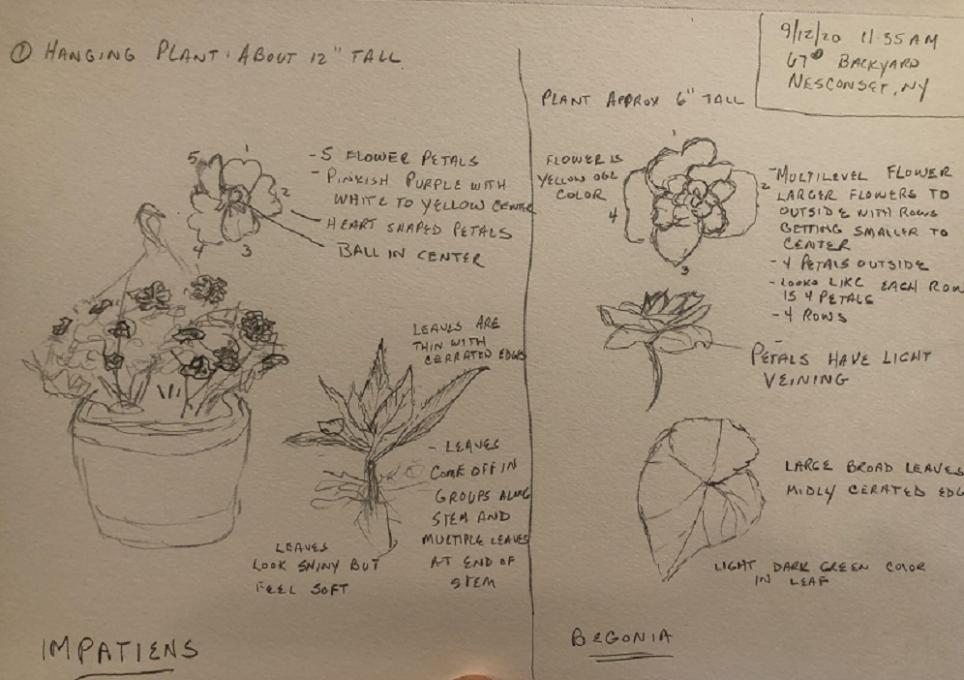


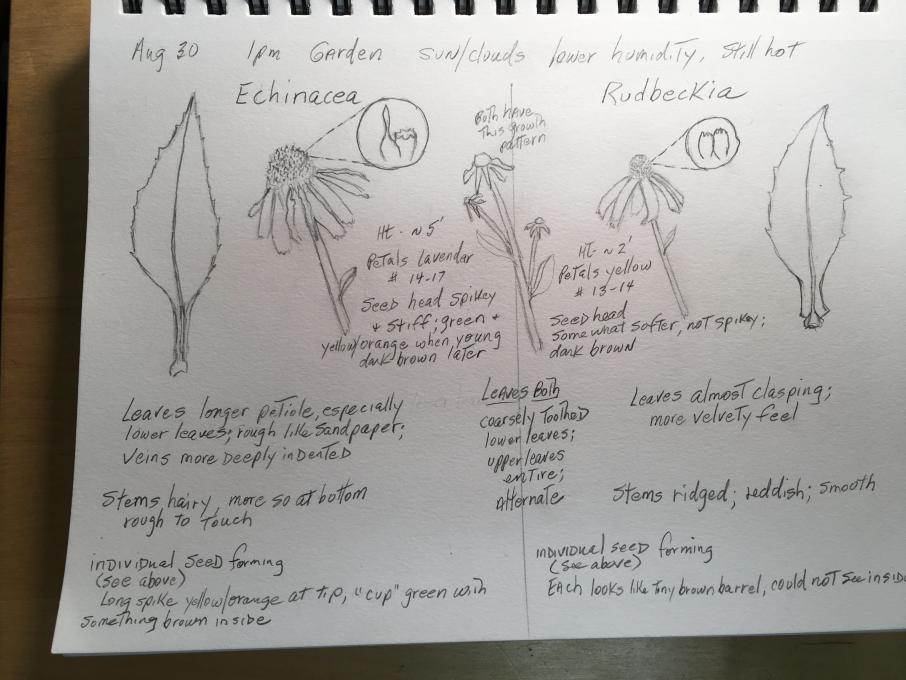 Enjoyed this exercise, found I noticed more details about each plant.
Enjoyed this exercise, found I noticed more details about each plant. 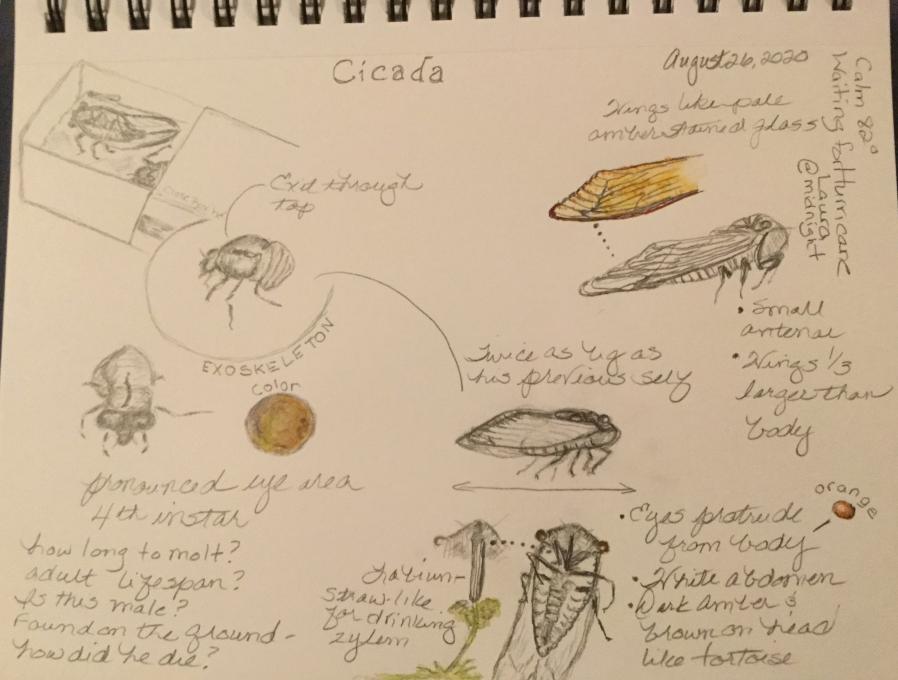 Really an intimate way to intersect art and discovery. This slow introspection allowed me to see the wonder and beauty of something I was quite fearful of prior to the study. As Hurricane Laura was not far from my area, I ventured inside and retrieved a matchbox with specimens from my yard. Originally meant for my grandchildren, I found myself the student! I have a greater appreciation for this noisy summer cicada.
Really an intimate way to intersect art and discovery. This slow introspection allowed me to see the wonder and beauty of something I was quite fearful of prior to the study. As Hurricane Laura was not far from my area, I ventured inside and retrieved a matchbox with specimens from my yard. Originally meant for my grandchildren, I found myself the student! I have a greater appreciation for this noisy summer cicada. 
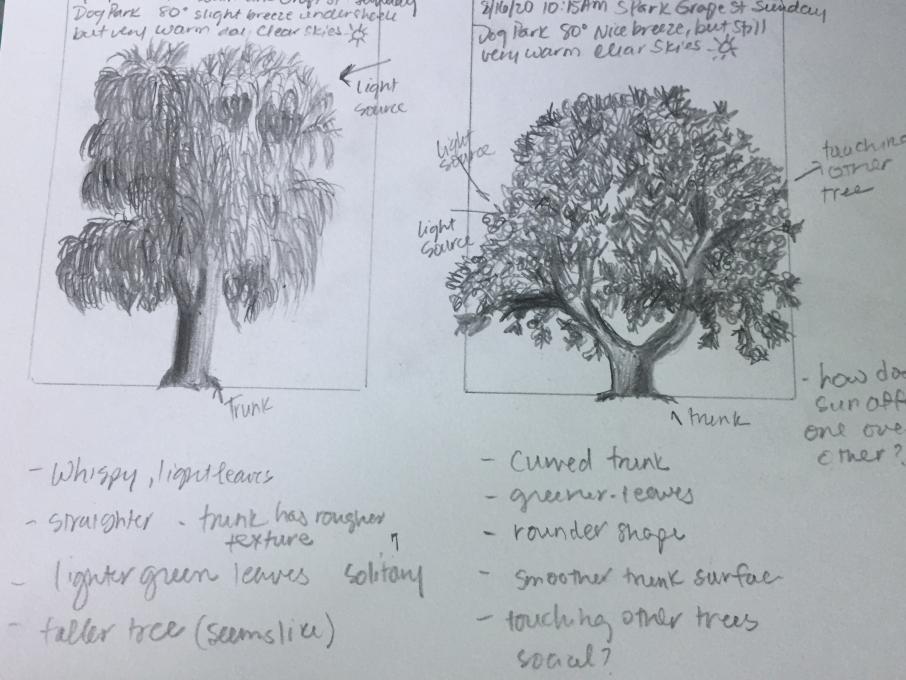
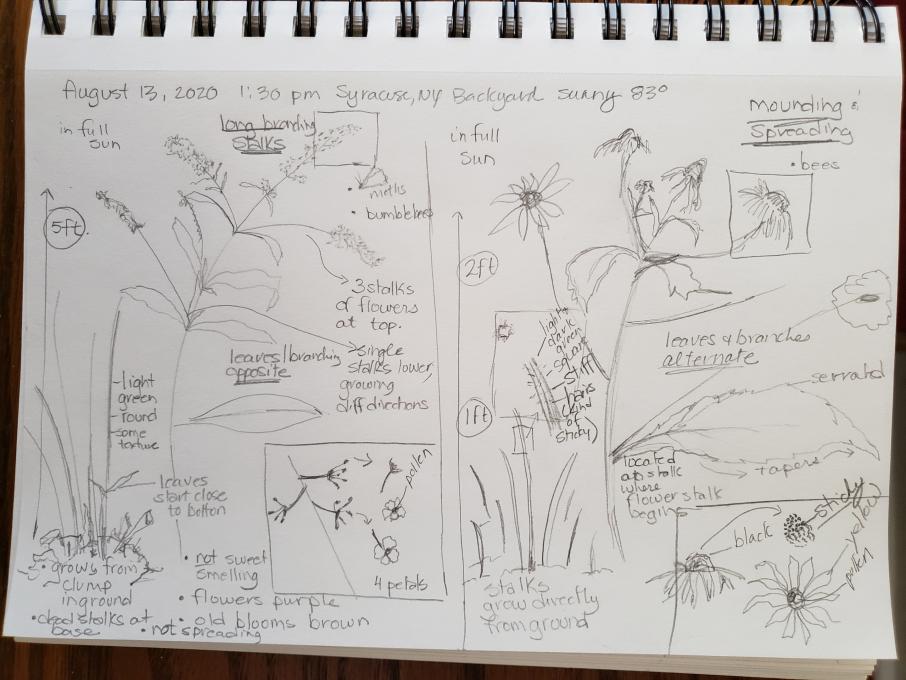
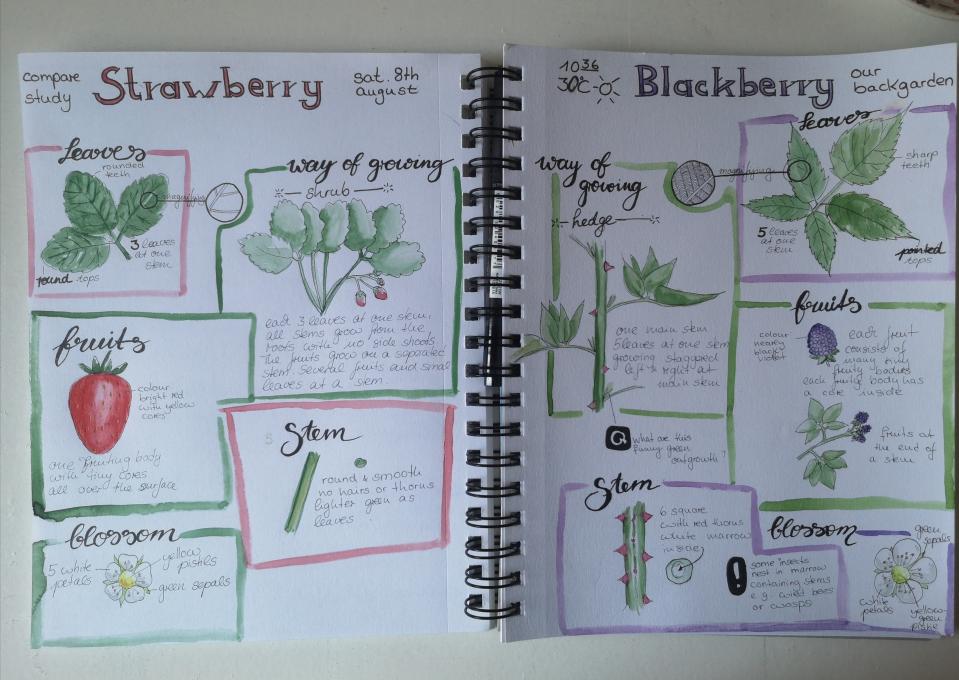 I compared two plants in my garden that I see every day but was looking at their details for the first time.
I compared two plants in my garden that I see every day but was looking at their details for the first time. 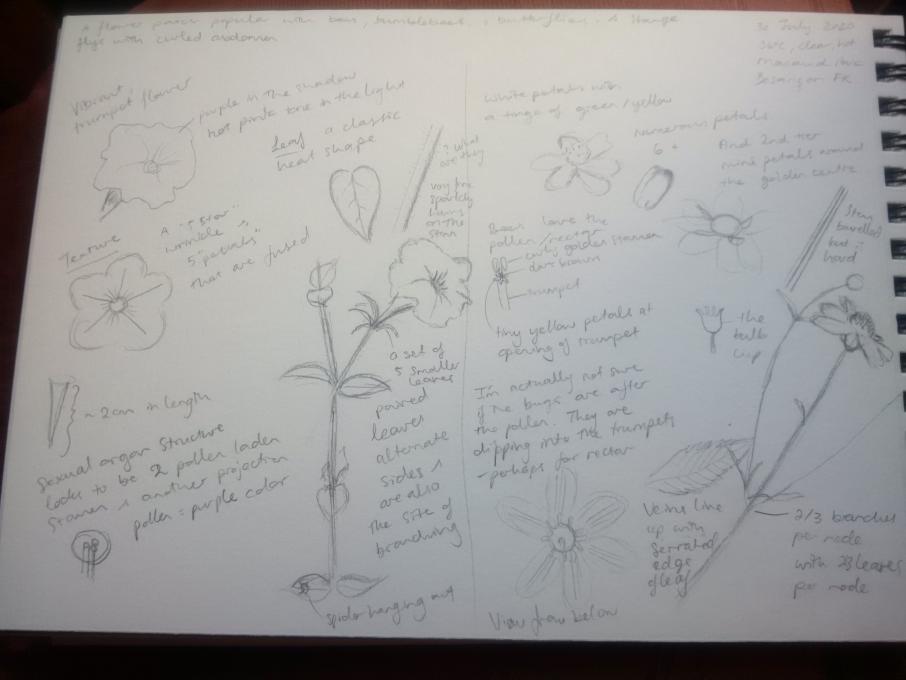 I compared two flowering plants in Parc Micaud, Besançon (FR). This comparative exercise is so useful for probing into questions of form. I would have liked to have a magnifying glass at hand to learn more; it was quite difficult to see some of the finer details with the naked eye but I had the feeling there was much more to learn!
I compared two flowering plants in Parc Micaud, Besançon (FR). This comparative exercise is so useful for probing into questions of form. I would have liked to have a magnifying glass at hand to learn more; it was quite difficult to see some of the finer details with the naked eye but I had the feeling there was much more to learn! 
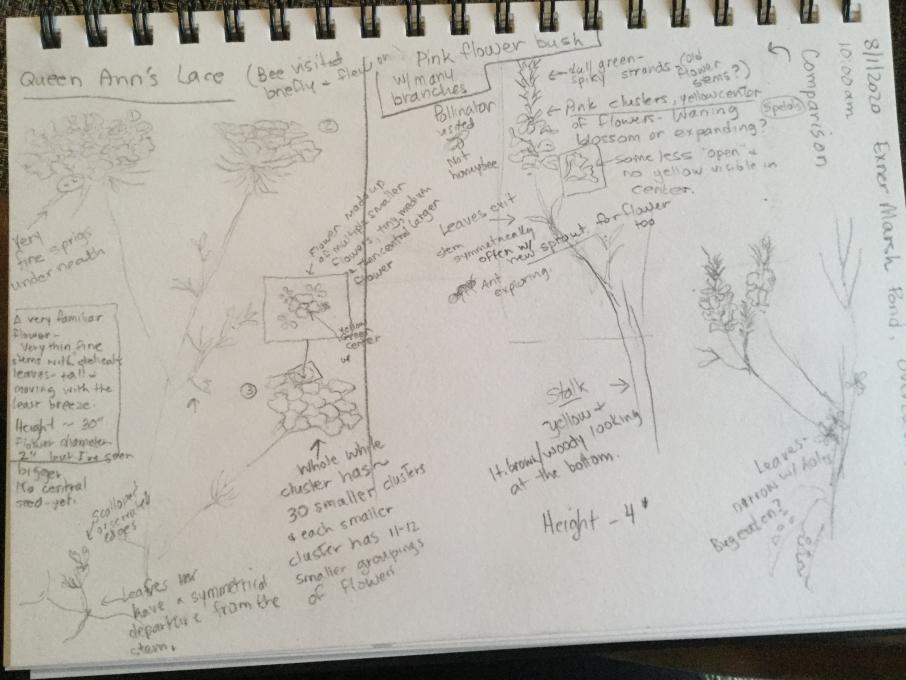 I selected a familiar wild flower and then one I was not familiar with. I was a little overwhelmed by the second one (Right side) . I think the Queen Anne’s lace was closer, easier to see and observe. The second one was more complicated but did make me think of a lot of questions about the flower portion, and leaves. Great exercise!
I selected a familiar wild flower and then one I was not familiar with. I was a little overwhelmed by the second one (Right side) . I think the Queen Anne’s lace was closer, easier to see and observe. The second one was more complicated but did make me think of a lot of questions about the flower portion, and leaves. Great exercise! 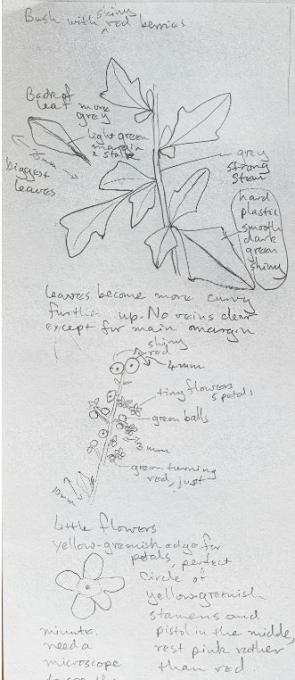
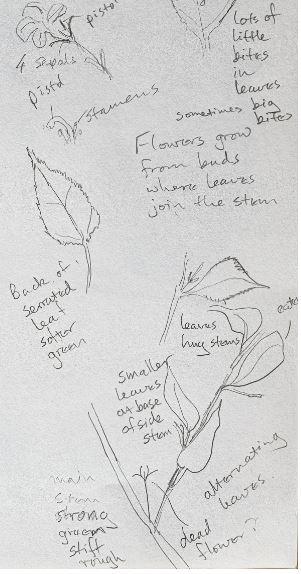 Such fun. I found tiny flowers where I thought there were only berries and flowers that seemed to grow from the base of leaves. The leaves were so different. Hard shiny plastic for the red berry and rough as a fine sandpaper for the second, although they looked so soft. Both weeds I suspect, next to a road. I could not find anything similar when I searched for names.
Such fun. I found tiny flowers where I thought there were only berries and flowers that seemed to grow from the base of leaves. The leaves were so different. Hard shiny plastic for the red berry and rough as a fine sandpaper for the second, although they looked so soft. Both weeds I suspect, next to a road. I could not find anything similar when I searched for names. 

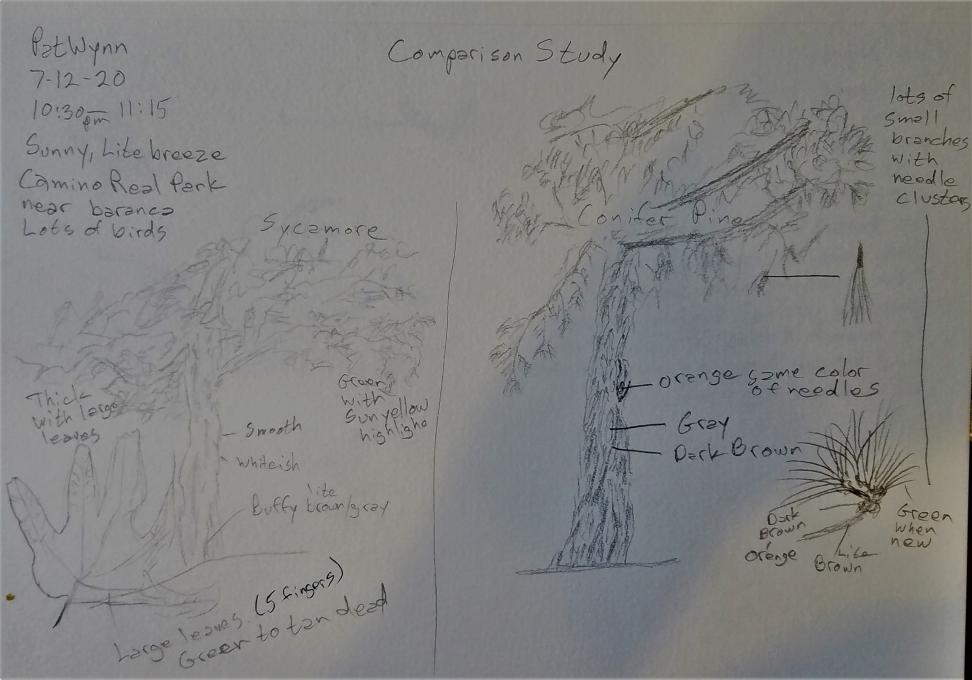 I have tried the comparison study, I compared two trees in a barranca park, I started with the bark, tree, structure, color, leaves, and needles. I had about 30 minutes to complete the assignment. I did experience a bit of trouble with my spacing in my sketch book. Also need to sketch darker and with a better plan, will need more practice.
I wondered why these trees were planted in this park. I noticed that there were a wide variety of very tall trees and many species of birds. I think that bird diversity for habitat played a key role with the many choices of trees planted. And the needles seem to draw small bug eating birds to the ground under the conifer pine trees.
I have tried the comparison study, I compared two trees in a barranca park, I started with the bark, tree, structure, color, leaves, and needles. I had about 30 minutes to complete the assignment. I did experience a bit of trouble with my spacing in my sketch book. Also need to sketch darker and with a better plan, will need more practice.
I wondered why these trees were planted in this park. I noticed that there were a wide variety of very tall trees and many species of birds. I think that bird diversity for habitat played a key role with the many choices of trees planted. And the needles seem to draw small bug eating birds to the ground under the conifer pine trees. 
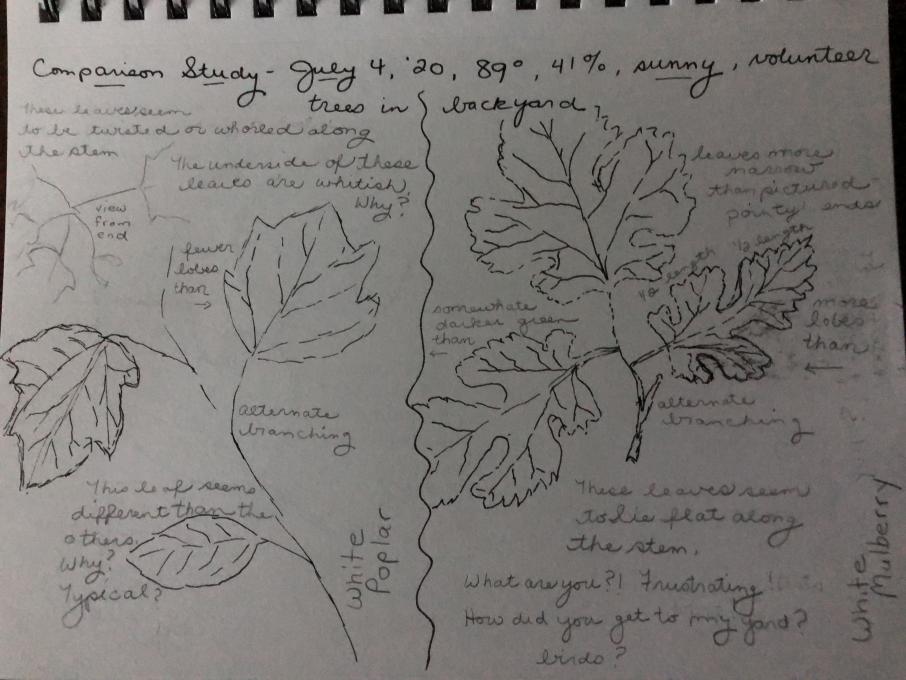
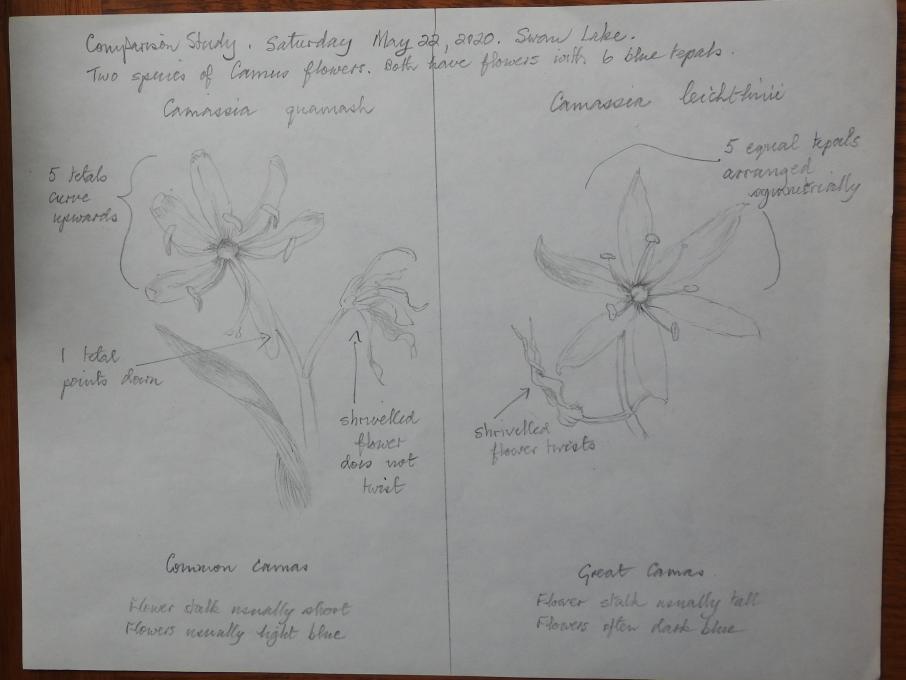 plants vary in size and colour. So, I decided this would be a good time to really look at both flowers to find some subtle differences.
plants vary in size and colour. So, I decided this would be a good time to really look at both flowers to find some subtle differences. 